Cucumbers thrive in warm and humid environments and are famous for greenhouse cultivation. Cucumbers grown in a greenhouse can help you extend your growing season and produce fresh, healthy cucumbers all year. Greenhouses provide a controlled environment ideal for growing cucumbers, as they need a lot of warmth and humidity to thrive.
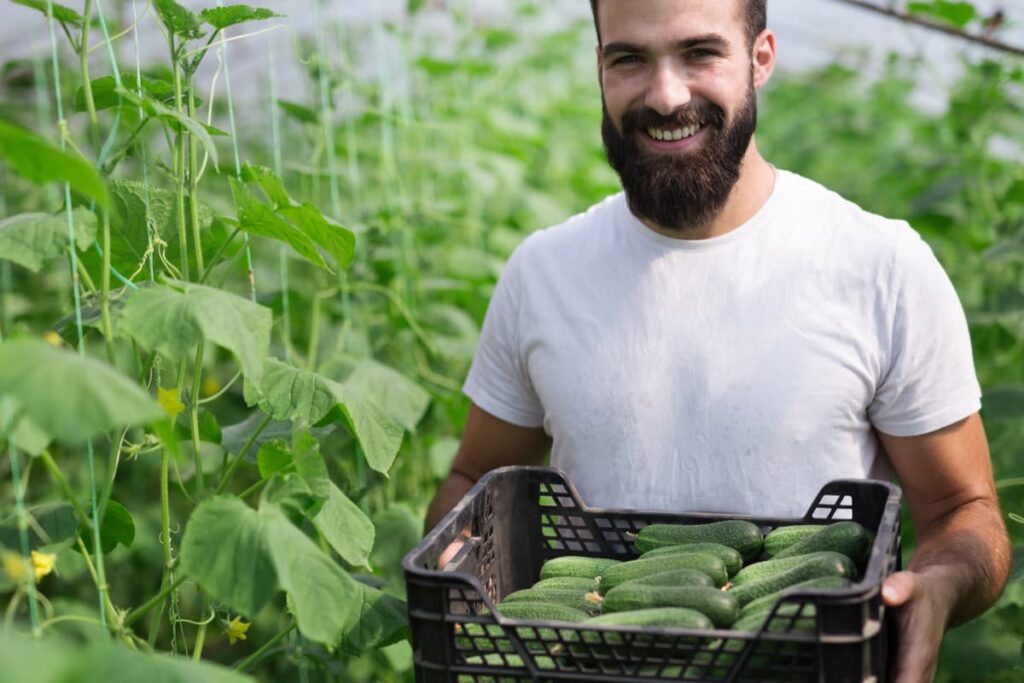
Growing cucumbers is a great place to start if you’re new to greenhouse gardening. Growing cucumbers is easy to do and to care for, and with some know-how, you can harvest fresh cucumbers in no time. This step-by-step guide will walk you through growing cucumbers in a greenhouse, from selecting the suitable variety to harvesting your crop. Let’s check out how do you grow Cucumbers in a greenhouse below.
Why to grow cucumbers in a greenhouse?
There are several reasons why growing cucumbers in a greenhouse can be beneficial:
- Extended Growing Season: Greenhouses provide a controlled environment that allows you to grow cucumbers year-round, regardless of the outdoor weather conditions.
- Increased Yield: Cucumbers grown in a greenhouse tend to have higher yields than those grown outdoors because the controlled environment promotes optimal growth.
- Protection from Pests and Diseases: Greenhouses provide a barrier between your cucumber plants and the outdoor environment, protecting them from pests and diseases that can damage or kill them.
- Improved Quality: Cucumbers grown in a greenhouse tend to have a better shape, size, and texture than those grown outdoors, which makes them more desirable for both personal consumption and selling.
- Space-saving: Greenhouses allow you to grow cucumbers in a small space, so you can still have a bountiful harvest, even if you have a small yard or balcony.
- Convenience: Greenhouses allow you to grow cucumbers closer to your market, so you don’t have to travel far to harvest them. Also, you don’t have to worry about the weather.
In case you missed it: How to Grow Cucumber Plants Faster: Best Tips to Increase Flowering, Fruiting, and Production Yield
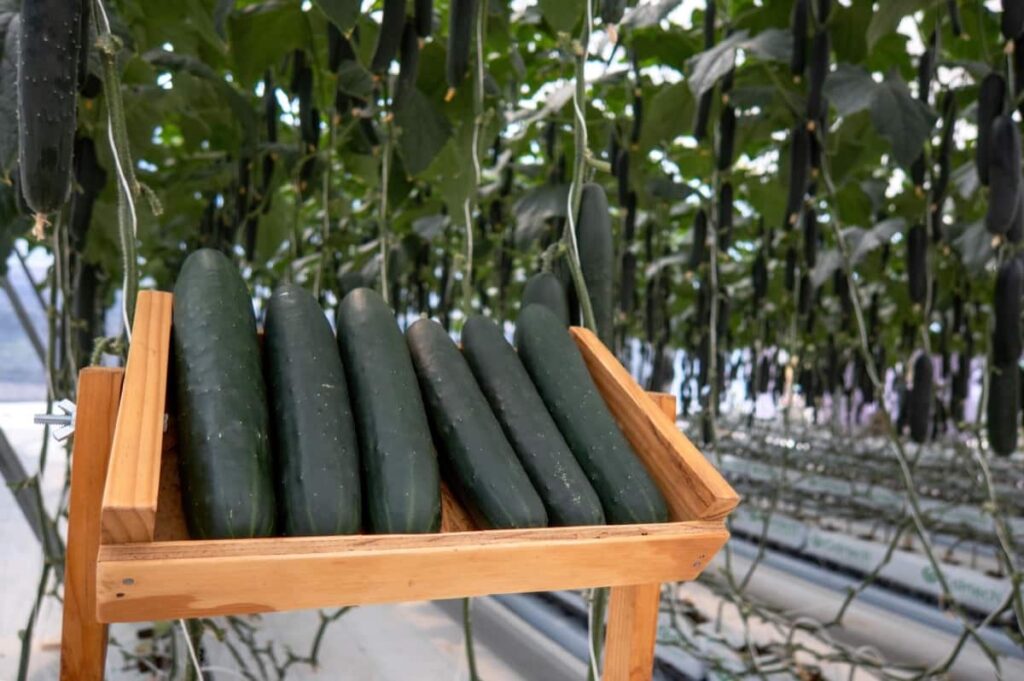
How do you grow Cucumbers in a greenhouse: A step-by-step guide for beginners
Best variety of Cucumbers to grow in a Greenhouse
- Maturity: Cucumber varieties vary in the time they take to mature. Some varieties, such as “Burpless” or “Lebanese” cucumbers, are ready to harvest in 50-60 days, while others, like “Marketmore” or “Diva,” can take up to 70-80 days.
- Size and Shape: Cucumber varieties come in different sizes and shapes. Some varieties, like “English” cucumbers, are long and thin, while others, like “Pickling” cucumbers, are short and stubby. Choose a variety that will fit the space you have in your greenhouse.
- Disease resistance: Some cucumber varieties are more resistant to common cucumber diseases, such as powdery mildew and downy mildew than others. Look for varieties that have a built-in resistance to these diseases.
- Yield: Consider how many cucumbers you want to harvest and choose a variety with good yield potential.
- Tolerance to heat: Cucumber varieties vary in their tolerance to heat. Some varieties, like “Cool Breeze” or “Suyo Long,” can handle warmer temperatures better than others, making them a good choice for greenhouse growth.
Popular varieties of cucumbers to grow in a greenhouse
- “English” cucumbers, which are typically seedless
- “Lebanese” cucumbers, which are shorter and thicker than English cucumbers with a slightly sweeter flavor and are also typically seedless
- “Salad Bush,” a cucumber, is a compact and bushier variety ideal for small spaces.
- “Suyo Long” cucumber, Which is heat tolerant variety and ideal for greenhouse cultivation.
- F1 Bella – female hybrid cucumber with powdery mildew resistance. In an unheated greenhouse, it produces abundantly and thrives.
- Cucumber ‘Diva’ – A mini-cucumber that produces exceptionally well in a greenhouse. There are no seeds, and the skins are silky with crisp flesh.
- Passandra F1. Organic mini-cucumber is resistant to powdery mildew and produces a lot of fruit. Expect tender, sweet meat.
Cucumber grown from seed Vs purchased young plants
When it comes to starting cucumbers, there are two main options: starting from seed or buying young plants. Both have pros and cons; the best option depends on preferences and circumstances.
In case you missed it: How to Start Cucumber Farming/Growing in Philippines: Check How this Guide Helps Beginners
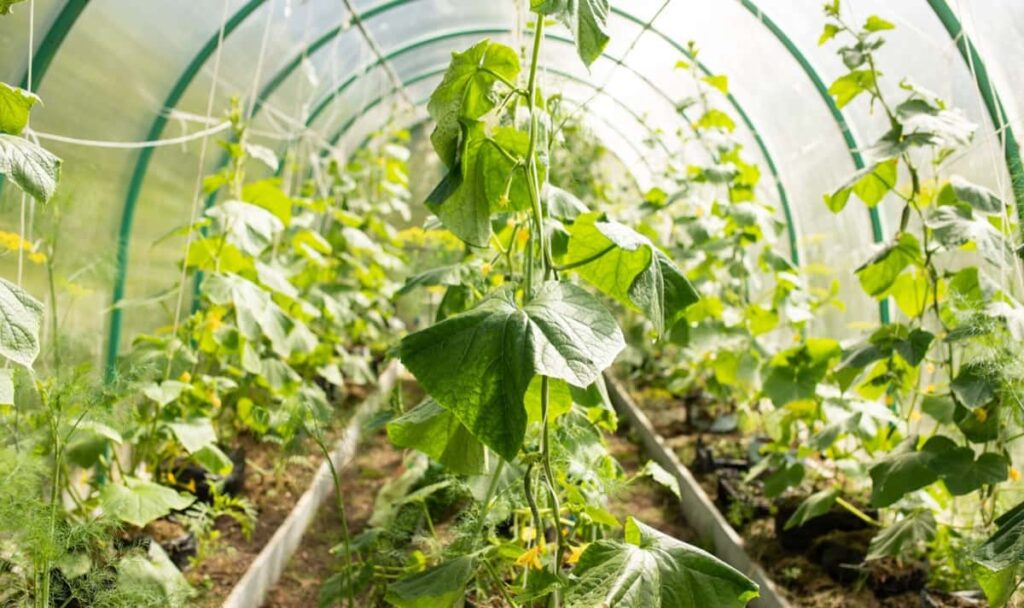
Starting cucumbers from seed
- Pros: Starting cucumbers from seed can be less expensive than buying young plants. It also allows you to choose from a wider variety of cucumber varieties.
- Cons: Starting cucumbers from seed takes more time and effort, as the seeds need to be started indoors several weeks before the last sowing date. The seedlings also need to be transplanted into the greenhouse when the weather is appropriate, which can be tricky.
Buying young plants
- Pros: Buying young plants is a quick and easy way to get started with cucumber growing. The plants are already established, so you can start harvesting cucumbers sooner.
- Cons: Buying young plants can be more expensive than starting from seed, and your variety choices may be more limited.
In general, starting cucumbers from seed is best for experienced gardeners with the time and patience to plant the seeds indoors and transplant them into the greenhouse. Buying young plants is a better option for those who want a quicker start and don’t mind paying a bit more.
Soil preparation to grow Cucumbers in your greenhouse
Preparing the soil is crucial for growing cucumbers in a greenhouse. Some tips to help you prepare the soil for your cucumber plants:
- Test the soil: Before you plant your cucumbers, Determine the pH and nutrient content of the soil. Cucumbers prefer slightly acidic soil with a pH between 6.0 and 7.5.
- Add organic matter: Cucumbers prefer well-draining, rich soil. Organic matter, such as manure or well-rotted compost, can improve soil fertility and structure.
- Improve drainage: Cucumbers do not tolerate waterlogged soil. If your greenhouse’s soil is heavy or clay-like, consider adding sand or perlite to promote drainage.
- Add fertilizer: A slow-release fertilizer can be added to the soil before planting.
- Create raised beds: Creating raised beds in your greenhouse can help improve drainage and make it easier to control the soil’s temperature.
Tips on how to grow Cucumbers from seed
- Start seeds indoors: Cucumbers should be started indoors several weeks before the last frost date. Plant the seeds in seed trays or pots filled with seed compost and place them in a warm 21 to 24 degrees Celsius location until they germinate.
- Provide proper lighting: As cucumber seedlings grow, they need bright light to develop strong stems. If you don’t have a sunny location, you can supplement the light using grow lights.
- Hardening off: Once the seedlings are big enough to handle, they should gradually acclimate to the greenhouse environment. This process is called hardening off and should be done over a week.
- Transplanting: When the seedlings are about 3-4 inches tall, and the weather outside is warm enough, you can transplant them into the greenhouse. Plant the plants approximately 18 inches apart, then stake or trellis them as they grow for support.
In case you missed it: Best Practices to Grow Cucumber at Home: Check How this Guide Helps Beginners
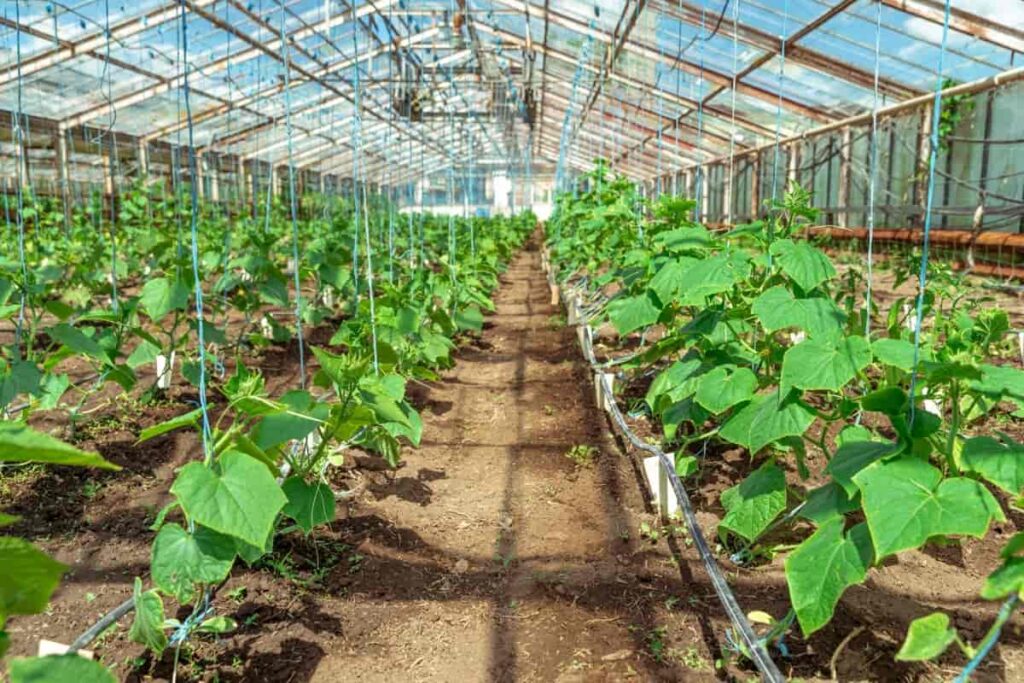
Cucumber growing tips for your greenhouse after transplanting
- Remove any male flowers (if the variety demands it) to keep the fruit from getting bitter. Male flowers lack the swelling caused by the developing fruit underneath them.
- Plants can be trained on a trellis or strings. Cucumber plants in full fruit can be rather heavy, so ensure the support can handle the weight.
- In hot temperatures, spray overhead.
- When plants reach the correct height, pin the tops or train them to grow in a different direction (but ensure they’re adequately supported). Remove any side branches as well.
- Pick the fruit regularly to stimulate additional fruiting and to collect it before it becomes too huge.
- Pile new compost around the base of the stem regularly. Every ten days, give a liquid feed.
- Watering: Cucumbers need consistent moisture, but be careful not to overwater as it can lead to Disease. A drip irrigation system can be an excellent option to keep the soil evenly moist.
- Provide proper temperature and humidity: Cucumbers prefer temperatures between 20-35 degree celsius during the day and 60-70°F at night. High humidity can lead to Disease, so it’s essential to have good ventilation and air circulation in the greenhouse.
How to support Cucumbers in a greenhouse?
- Trellising: Cucumbers can be trained to grow up a trellis or other vertical support structure. It saves space but also makes it easier to harvest cucumbers.
- Cages: Cucumbers can also be grown in cages similar to tomato cages. These cages support the cucumber plants and make it easier to harvest them.
- String: Cucumbers can also be grown using string or twine, which is tied to the greenhouse structure. The string is then wrapped around the cucumber plant as it grows, providing support.
- Stakes: You can also use wooden or metal stakes driven into the soil or container to support the cucumber plants as they grow.
It is possible to grow tomatoes and cucumbers in the same greenhouse. However, it is important to remember that these plants have different growing requirements. Tomatoes prefer warmer temperatures and more light, while cucumbers prefer cooler temperatures and less light. It is essential to ensure that the greenhouse is set up so that the different plants can be separated and given the conditions they need to thrive.
- Pests: Greenhouses can be a for aphids, spider mites, and whiteflies. These pests can damage the leaves and stunt the growth of the plants.
- Disease: Cucumbers are susceptible to several diseases, including powdery mildew, downy mildew, and bacterial wilt. These diseases can spread quickly in a greenhouse environment.
- Nutrient deficiencies: Cucumber plants need a balanced ratio of nutrients to grow and produce fruit. If the plants are not getting the right balance of nutrients, they may show signs of stunted growth or yellowing leaves.
- Lack of pollination: Cucumbers need to be pollinated to produce fruit. The plants may only produce fruit if the greenhouse has enough pollinators.
- Overcrowding: Cucumber plants need enough space to grow and produce fruit. If the plants are overcrowded, they may struggle to produce fruit and be more susceptible to Disease.
In case you missed it: Farming Business Plan PDF: for Poultry, Livestock, Agriculture, Horticulture, Greenhouse, and Hydroponic
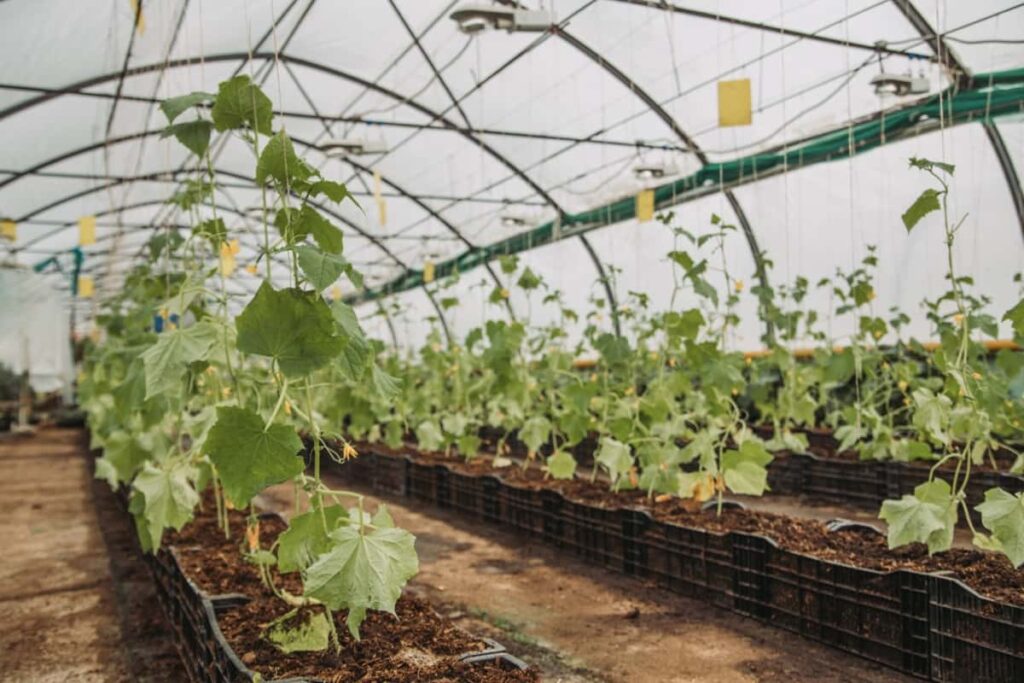
Pest and disease control in greenhouse Cucumbers
Pest and disease control is essential when growing cucumbers in a greenhouse. Monitoring: Regularly inspect the plants for signs of pests or diseases, such as yellowing leaves, wilting, or discoloration. Catching the problem early can make it easier to control.
- Powdery mildew: This type of mildew appears on plants as white, powdery spots. It is commonly caused by underwatering; water plants frequently to avoid this or get a resistant cucumber type.
- Cucumber mosaic virus: yellow mosaic pattern on the leaves. To prevent the illness from spreading, remove and destroy afflicted plants as soon as possible.
- Red Spider Mite – Causes rusty leaves. Remove and burn any damaged leaves. Whitefly – Can cause significant mold problems. Use organic or inorganic pesticides that are veggie friendly.
- Cultural control: Proper cultural practices can help prevent pests and diseases. For example, providing proper temperature, light, humidity, and nutrition can help keep plants healthy and resilient.
- Biological control: Using beneficial insects, such as ladybugs, lacewings, or parasitic wasps, can help control pests. Also, using beneficial microorganisms like Trichoderma can help control diseases.
- Chemical control: Chemical control measures may be necessary if pests or diseases are present. Always follow the label instructions and safety precautions when using pesticides or fungicides.
- Sanitation: Keeping the greenhouse clean and removing debris and old leaves can help reduce the population of pests and diseases.
- Quarantine: When introducing new plants to the greenhouse, be sure to quarantine them for some time to ensure that they are free of pests and diseases before introducing them to the main crop.
Reasons for slow growth and low fruit set in Cucumber
- Insufficient light: Cucumber plants need at least 6 hours of direct sunlight daily. If the plant is not getting enough light, it will grow slowly or not produce fruit.
- Incorrect temperature: Cucumber plants prefer temperatures between 70-75F. The plant may not produce fruit if the temperature is too high or too low.
- Lack of pollination: Cucumber plants need to be pollinated to produce fruit. If the plant is not getting enough pollination, it will flower but not produce fruit.
- Incorrect fertilization: Overfertilization can lead to excessive vegetative growth and insufficient fruit development.
- Pest or Disease: Pests or diseases can also cause slow growth or prevent the plant from producing fruit. Common cucumber pests include aphids, cucumber beetles, and powdery mildew.
- Improper pruning: Over-pruning or improper pruning can cause the plant to focus on vegetative growth instead of producing fruit.
In case you missed it: How to Start Microgreens Vertical Farming: For Indoors, Greenhouse, Growing Tips, Cost, and Benefits
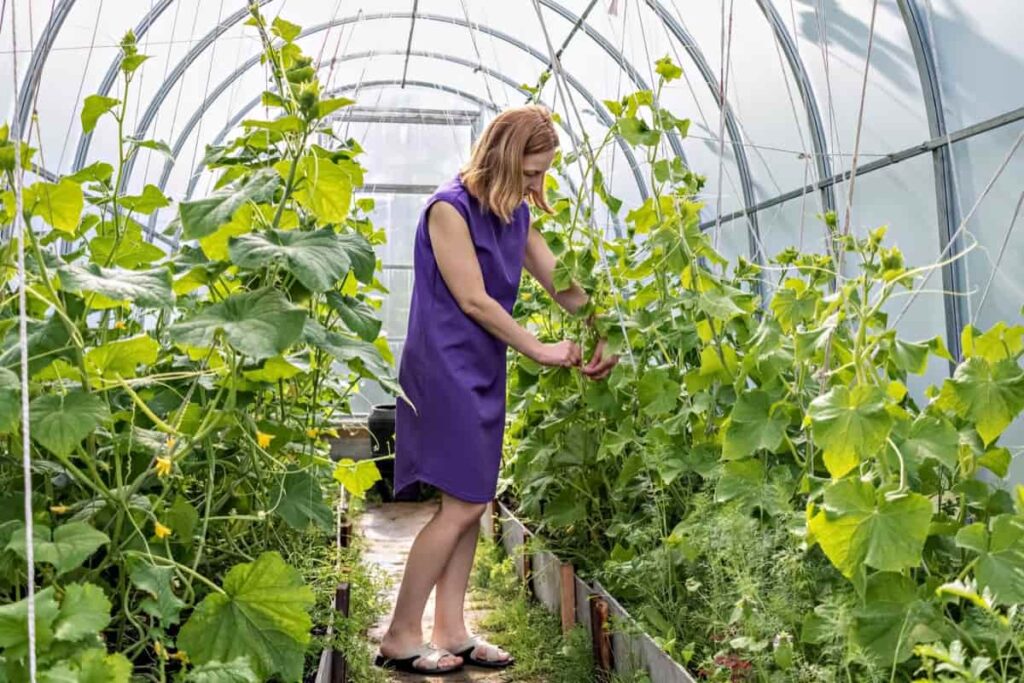
Harvesting and yield in Cucumbers from greenhouse
The yield of cucumbers from one plant in a greenhouse can vary depending on several factors, such as variety, growing conditions, and care. Generally, a healthy and well-cared-for cucumber plant in a greenhouse can produce between 10-15 fruits per plant. However, depending on the cultivar and growing conditions, some varieties can produce more or less.
Cucumbers grown in greenhouses typically have a higher yield per plant than those grown in outdoor fields due to the controlled environment that allows optimal growing conditions. The yield can also be increased by using techniques such as trellising, which allows the cucumbers to grow vertically and increases the amount of fruit produced per plant.
You can watch the video for boosting cucumber yield:
Harvesting should be done regularly to prevent over-maturity and to encourage continued fruiting. Cucumbers are typically ready for harvest about 50-70 days after planting, depending on the variety. Cucumbers should be picked off the vine using a sharp knife or secateurs. It will aid in preventing plant damage. Cucumbers grown in a greenhouse can produce better yields of more flavorful and crisp crops.
- Profitable Village Farming Business Ideas in 2024
- High-Yield Aquaculture: Fast-Growing Fish for Farming
- Effective Fish Pond Construction Techniques for Beginners
- Irrigation and Water Management in Pineapple Farming
- Blossom to Harvest: Mastering Flowering and Pollination in Papaya Farming
- Pig Fattening Essentials: From Selection to Sale for Beginners
- Raising Wagyu Cattle: A Complete Guide for Premium Beef Production
- Soil Types and Their Water Holding Capacity
- Optimizing Irrigation Schedules for Coconut Groves for Enhanced Yield
- Espresso Your Garden: Coffee Grounds for Healthier Acid-Loving Plants
- The Best Soil Mix for Snake Plants: How to Mix Your Own Snake Plant Soil
- Green Thumb Success: Expert Tips for Cultivating Greenhouse Beans All Year Round
- Bloom All Year Round: The Ultimate Guide to Indoor Hyacinth Care
- Eco-Friendly Gardening: How to Make Liquid Fertilizer from Kitchen Waste
- Ultimate Guide to Grow Anise in Pots: Explore Seed Propagation to Harvesting
- Guide to Raising Chester White Pigs: Discover Breed Facts to Growth Management
- Mastering the Elegance: The Ultimate Guide to Weeping Cherry Tree Care, Planting, and Maintenance
- Ultimate Guide to Planting Garlic in Grow Bags: Growing Strategies for Beginners
- How to Fix Spider Plant Leaf-Related Problems: Natural and Organic Remedies
- 10 Reasons Why Your Tulsi Plant is Shedding Leaves: Home Remedies and Solutions
- Optimizing Growth and Yield: The Advantages of Palm Bunch Ash Fertilizer
- Utilizing Neem Oil Extract as a Natural Pesticide for Hydrangea
- From Soil to Harvest: Various Ways in Which Farmers Can Use AI Tools
- Steps to Encourage and Induce Citrus Flowers: A Comprehensive Guide
- How to Fix Snake Plant Leaf-Related Issues: Natural and Organic Remedies
- Transform Your Garden into a Fragrant Oasis with Raat Ki Rani (Night Blooming Jasmine)
- Discover the Ideal Chicken Breeds for Philippine Farms
- How to Create a Poultry Egg Farm Business Plan for Profits
- Grow Lemon Cucumbers Like a Pro: Insider Techniques for Bountiful Yields
- Ultimate Guide to Caring for Your Pink Princess Philodendron: Tips for Thriving Variegation
- Areca Nut Profit Per Acre: Calculating Yield and Cost of Cultivation
- How Kaveri Chicken is Becoming a More Profitable Breed in Indian Backyards
- Transform Your Barn: 9 Steps to Convert a Horse Stall into a Chicken Coop
- Exploring Suffolk Sheep Disadvantages with Limitations and Challenges
- Guide to Solving Potted Lemon Tree Problems: How to Revive Lemon Tree in Containers
- Steps to Encourage Female Pumpkin Flowers: Best Strategies for More Flowers and High Yields
